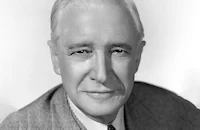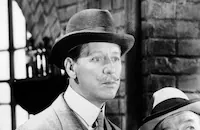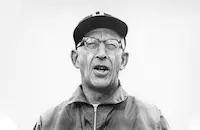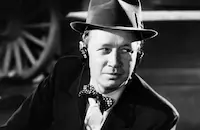Pardon My Sarong
Cast & Crew
Erle C. Kenton
Bud Abbott
Lou Costello
Virginia Bruce
Robert Paige
Lionel Atwill
Film Details
Technical Specs

Synopsis
Officials of the Chicago Municipal Bus Company are worried that cross-town bus 5111, driven by Algy Shaw and Wellington Phlug, has been stolen. In fact, the bus is on its way to Los Angeles with playboy Tommy Layton and his bevy of beauties aboard. Arriving at the Seaside Yachting Club, the group relaxes until private detective Kendall enters and arrests the two bus drivers for grand theft. The drivers manage to escape the detective, then sneak into a nearby theater where they hide in the dressing room of Marco the Magician. Disguised as Marco, Algy burns up the arrest warrant, with the assistance of the dumbfounded detective. Back at the club, Tommy mistakenly kisses Joan Marshall, the sister of his main competitor in an upcoming yacht race, and she accuses him of stealing her brother's crew. Meanwhile, Kendall re-captures the two bus drivers, but Wellington makes a wrong turn on the way back to Chicago, and the bus ends up in the Los Angeles harbor. Later, Tommy learns that Joan has tricked his crew into returning to her brother's ship. In return, he abducts her and hires the fugitive bus drivers to work as his crew. Once at sea, Tommy asks Joan to declare a truce, only to discover that she has rigged the compass and that they are hundreds of miles off course. After ten days lost at sea, the quartet finds land. The group explores the island, and the bus drivers find a native village. Wellington is mistaken by the villagers for the "hero" who will help them re-conquer their haunted temple in the mountains, and Luana, Chief Kolua's daughter, tells Wellington that he must marry her, much to the chagrin of Whaba, her warrior suitor. Meanwhile, Tommy and Joan find the hut of Varnoff, a treasure-hunter pretending to be an archaeologist. Varnoff and his gang then plot to use the shipwrecked quartet in order to rob the haunted temple of its sacred jewels. After Varnoff's men fake a volcanic eruption, Wellington is ordered to prove himself by entering the temple. At the same time, Tommy and Joan search Varnoff's hut and discover his true occupation. The two are captured, however, before they can warn the others. Wellington, too, is captured by Varnoff's men as he enters the temple, and they demand that he give them Kolua's sacred ruby. Wellington manages to escape his captors, and with Algy's aid, knocks most of the crooks unconscious. Meanwhile, Tommy and Joan break free of their bindings, but when Tommy gets into a struggle with Varnoff, Joan mistakenly hits the playboy in the head and is taken captive once more. Wellington sees Varnoff escaping in a small motorboat with Jane and gives chase. Using the sharp end of a swordfish as a weapon, Wellington jumps into the boat and apprehends the treasure-hunter. As the quartet prepares to return home, Luana gives Wellington a "thank you" kiss, making him so hot that steam rises when he jumps in the water.

Director
Erle C. Kenton
Cast

Bud Abbott

Lou Costello

Virginia Bruce

Robert Paige

Lionel Atwill

Leif Erikson
Nan Wynn

William Demarest

Samuel S. Hinds

Marie Mcdonald
Elaine Morey
The Four Ink Spots
Tip, Tap And Toe

Irving Bacon
Susan Levine

Jack Larue
Hans Schumm
Joe Kirk
Frank Penny

Charles Lane
Chester Clute
Tom Fadden
George Chandler

Sig Arno
Jane Patten
Jennifer Holt
Florine Mckinney
Marjorie Reardon
Lona Andre
Jayne Hazard
Barbara Slater
Helen Deverell

Audrey Long
Teddy Infuhr
William Cabanne
Sharky, A Seal
Herbert Vigran

Eddie Acuff
Jimmy Spencer
Phil Warren
Crew
True Boardman
Bernard B. Brown
Ted Cain
Howard Christie
Stanley Cowan
Milton Drake
Katherine Dunham
R. A. Gausman
Alex Gottlieb
John Grant
Arthur Hilton
Milton Krasner
Jules Levey
Bobby North
Ben Oakland
Martin Obzina
Jack Otterson
Gene De Paul
Nat Perrin
Charles Previn
Robert Pritchard
Don Raye
E. R. Robinson
Vera West
Clarence Williams

Film Details
Technical Specs

Articles
Pardon My Sarong -
Let's start with the movie studio. Universal Pictures was Hollywood's smallest outfit, and their perennial flirtation with bankruptcy made growth difficult. Past skids into financial trouble had been averted by an unexpected fad for Gothic monster movies in the early 1930s, or a public fascination for perky singer Deanna Durbin in the later 30s. As 1940 dawned, however, the studio was once again on the brink of ruin.
Meanwhile, vaudeville clowns Abbott and Costello had been hired as supporting players in 1940's One Night in the Tropics. It was a low-budget programmer, the sort of thing the studio churned out thoughtlessly--the movie equivalent of a bag of Cheetos. And when it made back millions of dollars in profit, with audiences clamoring for more of those bickering comedians, Universal rushed the duo into their own starring vehicle, Buck Privates (1941).
For years they held steady as one of the top box office attractions in the country. Their enormously profitable and popular films were exceedingly cheap to make--even as the boys' demands for special treatment escalated. Universal almost could not make enough Abbott and Costello pictures to meet demand.
Pardon My Sarong was their third comedy of 1942, and the eighth they made overall. Written by their longtime writer John Grant with the help of Marx Brothers writer Nat Perrin, and the colorfully named True Boardman (now working on his third Abbott and Costello picture), Pardon My Sarong is a loose, rambling collection of comedy bits. The boys accidentally steal a bus, drive it into the sea, go on the run from the cops, pretend to be magicians, fight some sharks, get shipwrecked on a Pacific Island, and defeat the villainous schemes of some gem thieves. Or, more precisely, the film finds the boys maintaining a running sequence of rapid-fire banter and slapstick shenanigans.
It was their bread and butter, and the stuff that thrilled early 40s audiences. It was also, sad to say, the cause of some unseemly backstage strife. But for that, first some history.
William "Bud" Abbott was more or less born into showbiz, or at least its seedier edges. His father was a promoter for the Barnum and Bailey Circus and his mother was a stunt rider. Bud naturally moved into the "family business" as it were, and started a long grind of a career in burlesque. His specialty was playing the straight man--the guy who served the setups for the comic to land the jokes. It was a sweet gig--not nearly as demanding as actually making the laughs, and it paid way better. Louis Costello was nearly ten years his junior, born to a middle class family and nurtured as an athlete. He abandoned those opportunities to run away to Hollywood with a crazy plan of breaking into the movies--which he eventually did, but only after some detours.
The two crossed paths in 1935, although there are enough stories about how they came to be teamed together to make every version suspect. No matter, somehow they started playing together on stage, then on radio, and five years later they landed a contract at Universal and rocketed to stardom. It was there, on the studio lot, that the seams started to show.
Abbott played a bully, who constantly mistreated his helpless and hapless baby-faced colleague. He was a perfect straight man, almost the dictionary definition of the term, but his persona had been honed for stage sketches and isolated routines. As the team became a beloved American institution, and anchored feature length motion pictures several times a year, the question was begged: why does the little guy put up with this?
Problematically, that's what Costello started to wonder to himself. His partner excelled at what he did, but was that enough? Bud Abbott was not a physical comic, he didn't sing, he couldn't really act. Abbott and Costello movies would always be limited by what Abbott could be expected to contribute.
They kept their arguments private, but split up in 1945 after a petty disagreement proved the final straw. They eventually patched things up, reunited, returned to the screen to face Universal's roster of monsters in Abbott and Costello Meet Frankenstein (1948) and went on to conquer television, before retiring their act in 1956 after a disastrous revue at a Las Vegas hotel.
In 1942, filming Pardon My Sarong, all of that was yet in their future. They were still young and new, but already hot enough to earn a higher caliber of costars: like leading lady Virginia Bruce, Preston Sturges favorite William Demarest, horror film star Lionel Atwill, and Western hero Leif Erickson. The film also finds time for several show-stopping musical numbers. Rock and Roll Hall of Famers the Ink Spots (comprised of Orville Jones, Charles Fuqua, Bill Kenney, and Deek Watson) made their second, and last, screen appearance here, and in one of their scenes were joined by acrobatic dancers Tip, Tap, and Toe.
Director Erle C. Kenton took over the Abbott and Costello films from their former director Arthur Lubin. Kenton was an ex-Keystone Kop whose background in both Mack Sennett slapstick and 1930s Gothic horror gave him a good grounding to handle the shifting tones of this mildly ambitious comedy. Originally titled Road to Montezuma, Sarong was fashioned in part as a self-conscious riff on the Bob Hope "Road to..." cycle and a spoof of the popular South Seas fantasies starring Dorothy Lamour. By the time Lionel Atwill shows up to chew some scenery as the heavy, Kenton tosses in some recycled music cues from Hans J. Salter's score to Ghost of Frankenstein (1942) for good measure.
Kenton hired choreographer Katherine Dunham to stage the various native dance scenes on the island, because he believed her to be the go-to expert for the dances of Tahiti. Dunham, an expert in Caribbean and African dance, figured he had confused Haiti with Tahiti, but a job was a job so why correct the man?
Pardon My Sarong was the second highest performing box office hit of 1942. With Costello and Abbott now earning a twenty percent cut of their films' revenue, it was a satisfying end to an enjoyable romp.
By David Kalat
Sources:
Leonard Maltin, The Great Movie Comedians.
Scott Allen Nollen, Abbott and Costello on the Home Front: A Critical Study of the Wartime Films
Barbara O'Connor, Katherine Dunham: Pioneer of Black Dance
James Robert Parish and William T. Leonard, The Funsters

Pardon My Sarong -
The Best of Abbott and Costello, Volume One
So why the popularity? Because Abbott & Costello had a type of goofy charm that comes through no matter what the circumstances and at their best were undeniable masters of comic dialogues. Good evidence can be found in the new DVD set The Best of Bud Abbott and Lou Costello, Volume 1 which contains their first eight feature films from 1940 to 1942 (the only one missing from that period is Rio Rita, presumably to be included in the next set). Better yet the entire package has a list price of $24.98 and despite such a budget price the films show crisp remastering and respect for detail. There are also some good though brief production notes included. The one drawback is that the discs and packaging don't tell you which side of which disc has a particular film; that information is only given on an insert.
In their first feature, One Night in the Tropics the duo are second-billed as a test for their screen abilities. They do manage to get off a couple of striking routines but it's the followup, Buck Privates (1941), that really showed what they could do. This is one of their best efforts, with the two unintentionally enlisting in the Army and the mayhem that results from that encounter; just imagine Lou trying to follow a drill sergeant's orders! With U.S. participation in the war looming, Abbott & Costello made two more service comedies that same year as morale boosters. In the Navy and Keep `Em Flying both follow the Buck Privates pattern though with enough fast and and snappy bits to keep things lively. Keep `Em Flying is particularly helped by the presence of ex-vaudeville comic/singer Martha Raye (who ironically enough was in real life afraid of flying).
Other Abbott & Costello films tend to present a high concept situation where the boys are let loose. Thus you'll find them in a haunted house (Hold That Ghost), a dude ranch (Ride `Em Cowboy), the South Seas (Pardon My Sarong) and a murder mystery (Who Done It?). None are classics even by A&C standards but generally work on sheer momentum. Hold That Ghost showcases a stream of sight gags (Lou's reactions to a mysteriously moving candle), twisting patter, peculiar characters and even songs courtesy of the Andrews Sisters. It's never more than the sum of its parts but most comedies don't even have parts that good. Still, an example of A&C at their weakest is Ride `Em Cowboy, one reason being because the team doesn't appear as often in it. Much of the time is instead given over to a tedious plot and lame singers, with the notable exception of a 25-year-old Ella Fitzgerald girlishly romping through her breakout hit "A-Tisket A-Tasket" (though unfortunately backed by a Hollywood orchestra instead of a jazz band).
Despite that film, it's hard to go wrong with a set at such a low price. Abbott & Costello won't appear on any future Sight and Sound polls but neither will they be forgotten.
. To order The Best of Abbott and Costello, Vol. 1, go to TCM Shopping.
by Lang Thompson
The Best of Abbott and Costello, Volume One
Quotes
Trivia
Notes
This was Bud Abbott and Lou Costello's first film upon returning to Universal after their free-lance performances in the M-G-M film Rio Rita . It was also the first film produced by Jules Levey's Mayfair Productions, Inc. for Universal under an agreement announced in a September 1941 Hollywood Reporter news item, in which Mayfair was designated as producer for all future Abbott and Costello films made at Universal. Despite this new agreement between Universal and Mayfair, Alex Gottlieb was retained as associate producer, a position he had held on previous Abbott and Costello films. With Pardon My Sarong, Erle C. Kenton replaced Arthur Lubin as director of the Abbott and Costello series. Numerous contemporary reviews point out that this film was a parody of the Dorothy Lamour "Sarong" films made at Paramount, such as Aloma of the South Seas (see entry above.) Hollywood Reporter reported that portions of the film were shot on location in Balboa, CA in mid-March 1942.
Early Hollywood Reporter production charts include Maria Montez in the cast, though she does not appear in the final film. For a three-week period, Hollywood Reporter production charts mistakenly listed George Robinson as the picture's director of photography, Richard H. Riedel as the associate art director and Milton Carruth as the film editor. According to modern sources, screenwriter True Boardman claimed that the plot of this film was confusing because after he would carefully work out a plot sequence of about twelve pages, and submit them to co-screenwriter John Grant, Grant would add gags and comedy routines to the material, while removing plot development and reducing the sequence to "about three pages." Modern sources also state that Sharky, the seal was actually named Charley, the seal.














